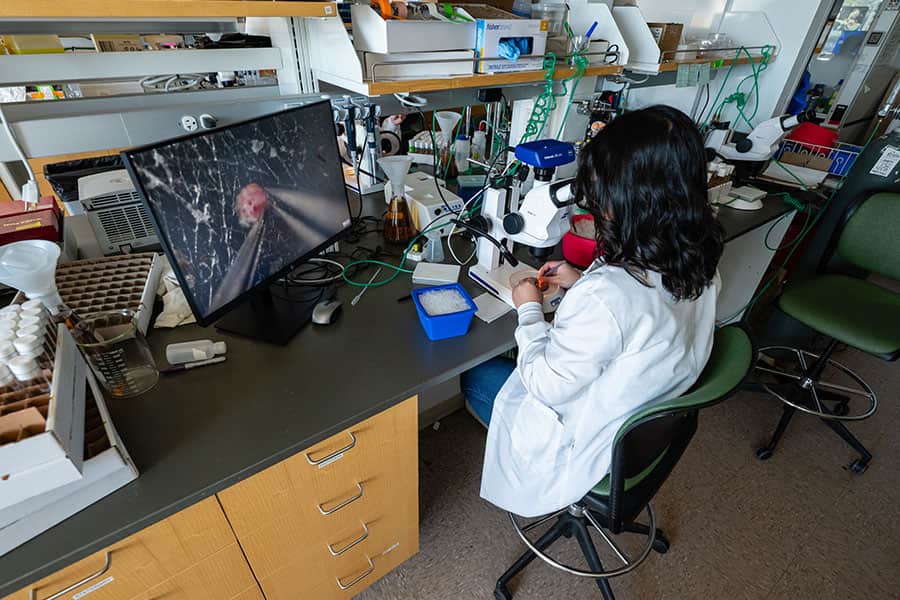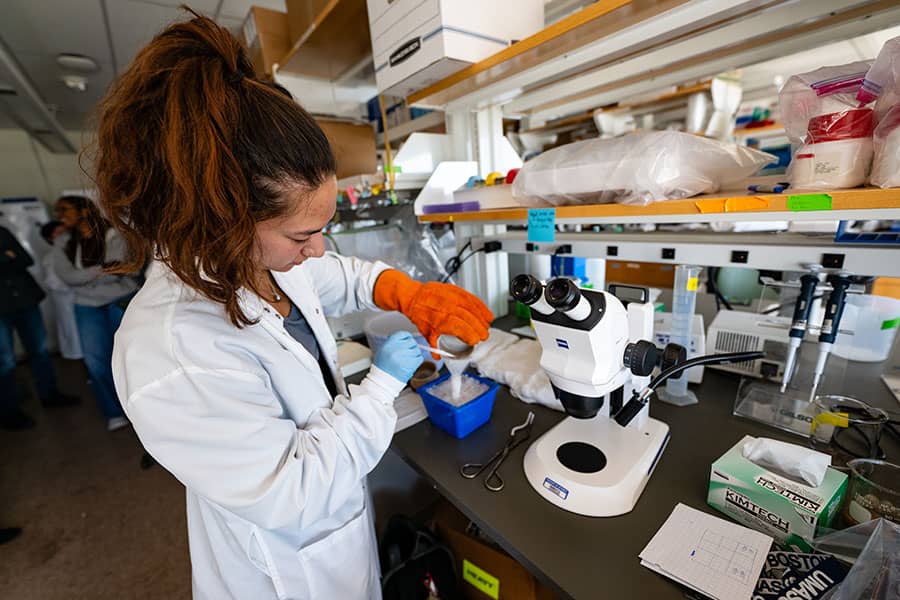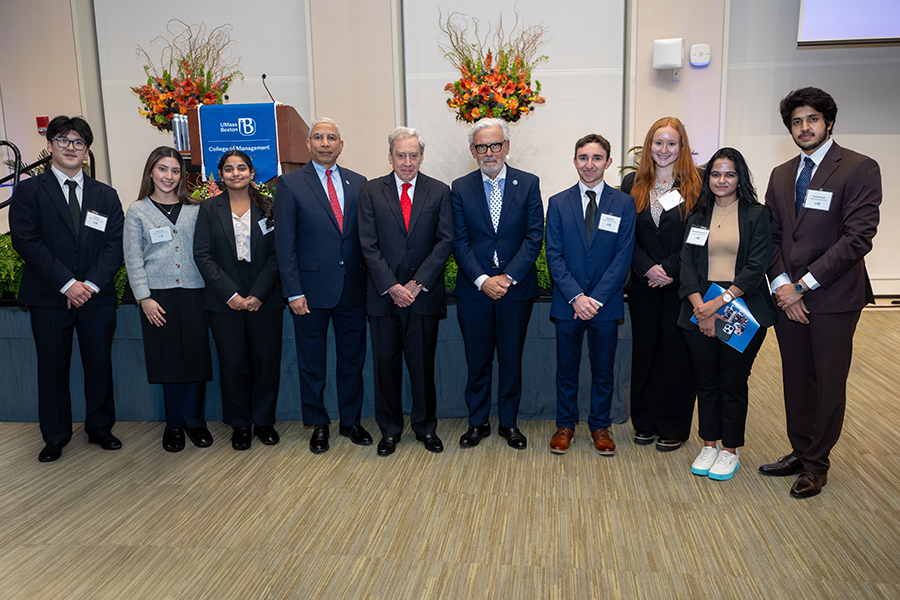In Fruit Fly Eyes, UMass Boston Researcher Sees Potential Medical Discoveries
Jens Rister, an associate professor in UMass Boston’s biology department, has just been awarded more than $1,700,000 in funding from the National Eye Institute of the NIH to research a protein that guides the development of color vision in fruit flies. By learning more about the underlying mechanisms, Rister hopes to learn about human diseases such as Oculoauricular Syndrome, a genetic condition that affects eyes and ears.
Humans see color using three separate kinds of photoreceptors, scattered across the back of their retinas. Each kind of photoreceptor cell can detect a different color: blue, red, or green. Rister’s lab focuses on one particular step of photoreceptor development: how each cell develops into a specific kind of color sensor.
Rister’s lab studies a protein, Hmx, which plays a key role in nerve cell development in many different organisms including worms, sea urchins, mice, and humans. Hmx is a transcription factor, which determines how DNA is read, and its instructions carried out, by the cell’s internal mechanisms. Despite its widespread use in the animal kingdom, Rister says that, until recently, the family of Hmx transcription factors was relatively understudied. “There was very little known, other than the fact that it’s expressed in nervous systems, especially about what it could do in developing eyes.” With the new National Eye Institute grant, the Rister lab will be able to continue their investigations.

Hmx mutations can lead to severe eye and ear disorders in humans, such as Oculoauricular Syndrome. This rare genetic condition is linked to malfunctions in the human equivalent of Hmx, called HMX1. Children with this condition can end up with various eye defects and deterioration of their photoreceptors, as well as underdeveloped ears. Understanding more about how HMX1 functions could help families that carry the mutations causing this disorder.
Fruit flies make good proxies for humans in genetic research: They are small, they breed quickly, their genes have already been thoroughly mapped, and scientists can easily generate mutants for study. Notably, fruit flies have five different kinds of color-sensing photoreceptors in their compound eyes, instead of humans’ three kinds. “However, we recently published that there’s a lot more similarity between the mechanisms that control fly and human photoreceptor development than previously assumed,” says Rister.
Joe Bunker G’24, a former PhD student in the Rister lab, discovered that Hmx controls how color-sensing photoreceptors develop in fruit flies. In fruit fly eyes, Hmx determines what specific colors the fly will be able to see. When Hmx is inactive, the photoreceptor becomes sensitive for the color green; when Hmx is active, the photoreceptor becomes sensitive for the color blue. As the eye develops, it must precisely control in which cells Hmx is active or inactive, so that the eyes have a chance to develop both types of photoreceptor cells.
The Rister lab’s prior research also revealed that Hmx interacts with a signaling pathway that suppresses tumors called Hippo, so named because fruit flies without a functional Hippo pathway develop bulbous, hippopotamus-like heads. Under normal conditions, the Hippo pathway and Hmx form an interactive cycle, in which they negatively regulate each other to ensure that the eye develops the right number of blue- and green-sensitive photoreceptors.
“When you find a novel regulator for a cancer-related pathway, you get very interested, obviously,” Rister says, even though he stresses that this work is still in the early days. “This pathway is highly conserved, humans also have it, and it’s linked to cancer in humans as well.” It's possible that studying how Hmx regulates the Hippo pathway could open some doors in human cancer research.

This project is supported by a team of UMass Boston students who work in the Rister lab. “We have an army of undergrads involved,” Rister says, citing the work of students in the REU, IMSD, McNair, and U54 programs. Graduate students, such as former master’s degree student Mhamed Bashir G’22, have made significant contributions as well. In addition to providing preliminary data, Joe Bunker was also involved in writing the successful NIH grant proposal, and received the biology department’s award for outstanding PhD thesis research for this work.
Rister adds: "It's really exciting and rewarding to have UMass Boston’s extremely talented students contribute at all levels of the scientific process—when you're making unexpected discoveries like this, everyone in the lab has the opportunity to push the field forward."
Latest University News
- At the Boston Globe Summit, UMass Boston Faculty, Staff and Students Tell Stories of Making an ImpactLuminaries from art, science, business and politics gathered to give lectures and discussions on this year’s most important issues. UMass Boston was a proud sponsor of this year’s Boston Globe Summit.
- UMass Boston’s College of Management Celebrates 50 YearsThe UMass Boston College of Management marked a defining milestone as faculty, staff, students, alumni, and university leaders gathered to celebrate the college’s 50th anniversary - five decades of expanding access to high-quality business education.
- UMass Boston’s Sixth Annual Black Lives Matter Day Honors Black Cultural Resilience in Challenging TimesAt a moment when Black culture is being legislated against, sanitized, and distorted in public memory, UMass Boston gathered on November 3 for something far more potent than a university event. The sixth annual Black Lives Matter Day was a reminder that Black culture is not a side note in American life, but a backbone and creative engine that has carried generations through both devastation and possibility.
- UMass Boston Marketing Professor Named One of the World’s Most Influential ResearchersProfessor Werner Kunz of the College of Management has been named a Highly Cited Researcher 2025 by Clarivate, recognizing him as one of the world’s most influential researchers.
- Student-Athlete Nathan Rubin Debuts Children’s Book "Chasing a Dream"UMass Boston basketball player and economics major Nathan Rubin has published a children’s book to inspire kids to dream big and work toward achieving their goals.
- UMass Boston Researcher Receives Grant to Study Cyberattacks on Power GridsIoannis Zografopoulos, an assistant professor in the Engineering Department of the College of Science and Mathematics at UMass Boston, has been awarded a grant from the National Science Foundation (NSF) to study the cybersecurity of power grids targeted by communications-based cyberattacks.













